As the sun rises over the distant hills in Lovelock, Nev., we begin a short drive on Interstate Highway 80 before snaking up the paved roads to Coeur d’Alene Mines‘ (CDM-T, CDE-N) Rochester silver-gold mine, located 41 km northeast in Pershing County.
The scenery varies little. Sagebrush dots the plains and sandy hills stretch along the horizon under a bright, blue sky.
It’s late September, and the largest U.S.-based primary silver producer has arranged for analysts and The Northern Miner to tour the 29-sq.-km property nestled within the Humboldt mountain range at an elevation of 2,000 metres.
Rochester has a long history, Cindy Jones, the mine’s general manager, says during the property tour. Coeur has operated at Rochester since 1986, generating 128 million oz. silver and 1.4 million oz. gold to date from 161 million tons. The Rochester mine contains the Rochester and Nevada Packard pits, which sit 4.8 km apart.
The company bought its longest running mine in 1983 from smelting and refining company Asarco and began leaching it three years later.
In 1999, it acquired Nevada Packard and started an open-pit mine there in 2002.
But five years later, Coeur ceased all mining operations and began residual leaching from two of its fully loaded, stage two and stage four heap-leach pads.
This is when the ounces started dropping off, Jones explains, adding that the company plans to turn that around by building a new stage-three leach pad, dubbed “pad three,” and by resuming mining activities.
Pad three’s production will kick off this quarter. Based on the mine’s reserves, it could add seven years to Rochester’s mine life.
The Rochester pit hosts reserves of 48 million tons grading 0.57 oz. silver and 0.005 oz. gold per ton for 27.5 million oz. silver and 247,400 oz. gold. Nevada Packard does not have any reserves.
From the 48 million tons that will be placed on the new leach pad, the company expects to yield 16 million oz. silver and 220,000 oz. gold.
“We are on the cusp of the resurgence in production,” Mitchell Krebs, Coeur’s president and CEO, said in a November conference call. “Production begins this fourth quarter from the new leach pad that was constructed this year, which adds seven more years of silver and gold production from our longest running mine.”
The company prepared the 50-million-ton pad in September, and workers lined the designated 59 hectares. The following month, miners loaded crushed ore onto the heavily lined pad. The ore goes through three stages of crushing before it’s delivered. By the end of October, the pad contained 400,000 oz. silver and 4,000 oz. gold.
“We will continue loading that much material each month, and we will expect rapid recovery in the first thirty to sixty days of placement, which will drive higher productions in the fourth quarter,” Leon Hardy, Coeur’s new senior vice-president and chief operating officer, explained in the conference call.
About half of the metal leaches out quickly during the first two months, Krebs explains in an
interview, adding that the other half takes a while to dissolve. Because of this, there should be a bump in production for the first quarter of 2012 compared to the fourth quarter. Afterwards, the output should remain fairly
constant.
Coeur averages annual production at 2.4 million oz. silver and 35,000 oz. gold through 2017.
New production, along with residual leaching from the older two and four pads, should bring the company a step closer to this year’s company-wide production guidance of 19.5 million oz. silver and 220,000 oz. gold.
General manager Jones concedes that Coeur had a larger reserve while planning pad three, so it erected pad four instead, which has a 100-million-ton capacity.
She adds that the company’s first 25-million-ton pad took off in 1986 and ran for 10 years before it was reclaimed in 2001. It was also the only pad to experience a leak, which the miner identified and fixed in 1991.
By the mid-1990s, production from pads two and four came online. Pad two has the same 50-million-ton capacity as the new pad.
Residual leaching from the older pads will dwindle off at a pretty rapid rate, Krebs comments, but will continue throughout next year before “tapering off to next to nothing in 2013.”
A year after mining came to a halt in 2007, the company initiated a handful of engineering studies looking to expand Rochester and restart operations, followed by a prefeasibility in 2009.
It also outlined for the Bureau of Land Management a plan to build a new heap-leach pad and resume mining, and continued with additional studies in 2010. The agency gave its initial approval in August 2009, following two environmental nods in October 2010.
This year with final permits from various agencies in hand, Coeur began building the new pad.
The company brought on three silver-gold mines between 2008 and 2010 while waiting to swing Rochester back into action, starting with San Bartolome in Bolivia, Palmarejo in Mexico and Kensington in Alaska.
The company also holds the Martha silver-gold mine in Argentina and the Endeavor silver mine in Australia.
The three new mines kicked in during this year’s solid second quarter, says Wendy Yang, Coeur’s vice-president of investor relations. Coeur followed up with a strong third-quarter performance, reporting all-time record sales and operating cash flow for the period, as well as for the first nine months.
The three months ended Sept. 30 also beat consensus estimates for adjusted earnings and operating cash flow.
“Coeur d’Alene surprised us and surprised the market,” says J.P. Morgan analyst John Bridges. “We were looking at seventy-seven cents [of adjusted earnings U.S. per share], and they reported what we estimate a clean number of one dollar and four cents. So it was well above expectations.”
Quarterly sales came in at US$343.6 million, with operating cash flow at US$151 million.
“Our increasing quarterly cash flow has strengthened our cash and equivalents balance to over two hundred million U.S. dollars,” Krebs remarks. “Late last month we paid off the remaining eighteen million U.S. dollars of senior notes, leaving only one hundred twenty-eight U.S. dollars of remaining debt, equivalent to less than three months of cash flow.”
A strong quarterly run by the Palmarejo gold-silver mine and San Bartolome silver mine contributed to the US$31.1-million profit.
The miner churned out 4.9 million oz. silver and 57,000 oz. gold during the quarter.
For the first nine months, the company saw significantly higher sales of US$774.3 million and US$356.9 million in operating cash flow, and generated 13.8 million oz. silver and 170,838 oz. gold.
Looking ahead, Coeur remains on track to meet this year’s guidance of 19.5 million oz. silver at a cash operating cost of US$5.75 per oz. However, the company has lowered its gold production estimate to 220,000 oz. from 240,000 oz., owing to temporarily slowed production at the Kensington gold mine.
Over the next six months, Coeur plans to lower processing rates by half at Kensington to complete “several key initiatives.”
“They decided they needed to slow down production so they could develop more ore and drill up the deposit,” says Bridges of J.P. Morgan. “The bottom line is that when they started that mine up [in mid-2010], they were short on cash. In a mine like that, what you really want to have is a couple years of reserves proven up, and tunnels to access those reserves. Then you can get flexibility in how you mine the orebody, and they don’t seem to have that. It’s something they feel they have to have and they are willing to accept a weak fourth quarter so they can.”
Despite the setback at Kensington, the company anticipates US$1
billion in total sales and US$500 million in operating cash flow for the year.
Gearing up Rochester
Coeur’s flagship Nevada mine contributed 1 million oz. silver and more than 4,000 oz. gold from residual leaching during the first nine months.
To reach its yearly target of 19.5 million oz. silver and 220,000 oz. gold, the company must churn out 5.7 million oz. silver and 49,000 oz. gold in the fourth quarter.
During this time, Rochester is anticipated to contribute 553,000 oz. silver and 12,000 oz. gold versus the 350,000 oz. silver and 1,400 oz. gold generated in the third quarter.
With the new pad active, cash operating costs will also steady out, with improvements showing in the last quarter of this year.
“The third-quarter cash cost [of US$36 per oz.] is kind of a funky number,” Krebs concedes. Given that Rochester is already a producing asset, all the costs that went into creating the new pad were expensed instead of capitalized, Krebs explains. Then those costs were spread over the number of ounces produced. Coeur spent US$35 million this year to build the new pad.
Before year-end, Krebs sees the cash operating cost dropping to US$12 per oz. before settling in the US$10 range during 2012’s first quarter.
At first glance, a US$35-million price tag on the new pad may seem a bit high, but Krebs explains it’s a great investment because it extends the mine life by seven years.
“That is a high triple-digit rate of return,” he notes. “As far of deploying cash flow to high-return opportunities, Rochester is as good as it gets . . . it’s a great opportunity for us.”
Opportunity keeps knocking
“Rochester is our most dynamic mine right now, in terms of all the opportunity we have there to grow and create value in a low-risk, high-return kind of fashion,” Krebs says.
Since the new pad only takes care of the mine’s current reserves, Coeur plans to make use of the favourable silver and gold price to build a bigger pad, named stage five, or pad five.
That pad will be used to leach Rochester’s remaining 235 million tons of resources, which the company is working to classify as reserves.
In the measured and indicated category, the mine’s two pits contain 215 million tons grading 0.44 oz. silver and 0.003 oz. gold for 94.3 million oz. silver and 708,800 oz. gold. It has another 21.9 million tons of 0.65 oz. silver and 0.003 oz. gold for 14.2 million oz. silver and 68,700 oz. gold in inferred.
“That’s what really gets me excited,” Krebs says about pad five, which is part of Coeur’s next
generation of leaching.
Estimated to be four times the size of pad three, the 200-million-ton pad could add 15 years to Rochester.
Like pad three, pad five is possible because of the rising prices for precious metals.
“Rochester is a wonderful success, helped by higher silver and gold prices,” says analyst John Tumazos of Very Independent Research.
During the last 25 years, the low-grade material was not economic to mine with low prices. But now, with ascending prices and better mining equipment, the company can economically extract material.
During the third quarter, average realized prices for silver more than doubled from the year-ago period to US$38.28 per oz., while the price of gold increased by 33% to US$1,681 per oz.
“Assuming the silver price remains reasonably high, Rochester should be a backbone of their production,” Bridges notes.
Coeur’s CEO couldn’t agree more. He believes the macro issues – such as the debt problems in Europe, the U.S. deficit and the debasement of currencies – will keep up investment demand for silver, and that the need for electronics and new technologies will boost industrial demand.
With the construction of the new pad, followed by pad five, Krebs sees Rochester climbing back up the ranks, which he believes “will vault Rochester back into becoming one of Coeur’s most significant assets in terms of production and cash flow.”
The miner plans to submit permits for pad five early next year. It would take two to three years to get all the permits before the building starts.
Krebs is thrilled about the new leaching pads and ongoing exploration. His enthusiasm matches that of Coeur’s senior vice-president of exploration, Don Birak.
“What we are looking at are
opportunities to expand,” says Birak at Rochester. “What’s going to be next? We never stop looking at what’s next.”
At the moment, the company is upgrading resources, finding new mineralization and revisiting old waste dumps.
“We are looking at how we can grow the reserves, from both converting resources to reserves and extension from exploration,” Birak explains. “We are drilling to extend the size of the deposit. We have those things going on simultaneously.”
In the third quarter, Coeur doubled drilling to more than 12,800 metres compared to the prior quarter’s 6,800 metres. The drills were focused on Northwest Rochester, which is north of the current Rochester pit, and Nevada Packard.
Some drill highlights from Nevada Packard include 23 metres grading 0.002 oz. gold and 1.44 oz. silver per ton, and 15 metres at 0.017 oz. gold and 2.65 oz. silver per ton.
A notable intercept from Northwest Rochester returned 0.001 oz. gold and 2.03 oz. silver per ton over 43 metres.
“That is just good old-fashioned drilling success that they are having,” Krebs comments. “There have been great results from classical exploration activities that will create a third opportunity for us [after pads three and five] to further expand and augment what we are putting in place over the next couple of years.”
The drills will continue turning at Rochester into 2012.
The waste dumps that have accumulated over 25 years of mining could potentially extend the mine’s life. Krebs says that they contain material with grades that are well in excess of the grade of current reserves, and adds that the company will examine them to get a better handle on what the waste dumps contain, and whether they can be reprocessed and releached.
Coeur’s CEO continues to rave about the potential juice left in the mine.
“It’s amazing down here – whether it is the pit or laying back those pit walls, or exploration or the waste dump. For a mine that has been in operation for twenty-five years to have so many different ways of growing and adding new production and cash flow for the company, it’s a fun and exciting time at Rochester.”

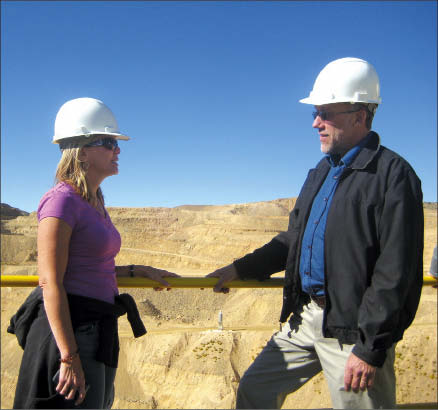
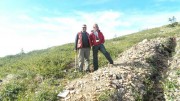
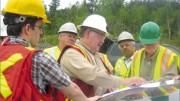
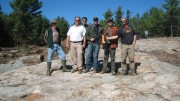
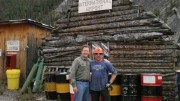
Be the first to comment on "Coeur’s Rochester poised for a comeback"